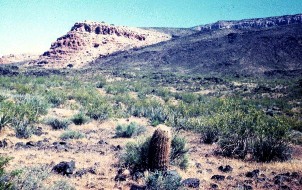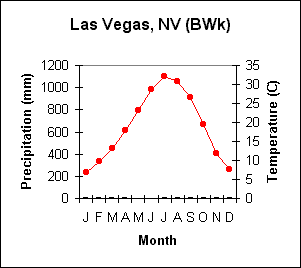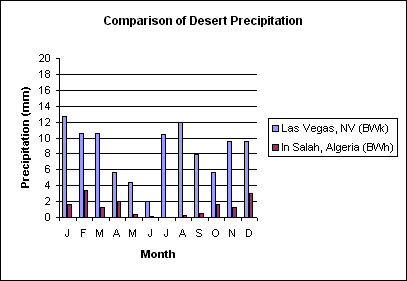9.5.2: Midlatitude Desert Climate
- Page ID
- 16099
The midlatitude desert shares many of the same climatic characteristics as the tropical deserts, and for many of the same reasons. While the tropical desert climates are considered "hot" deserts following Köppen's classification (BWh), midlatitude deserts are "cold" deserts (BWk).

Geographic Distribution
The midlatitude desert is found in inner Asia with great expanses in northern (Gobi desert) and northwestern China (Takla Makan desert), Kazakhstan, and Uzbekistan. The interior western United States (Southern Utah and Nevada, Arizona, New Mexico) has a midlatitude desert climate.
Controlling Factors

The midlatitude desert climate is controlled by the same factors as the tropical desert climates, the influence of high pressure, interior position, and rain shadow location. The Takla Makan desert exhibits this influence well as it lies in a depression ringed by mountains preventing even the most meager amount of moisture to penetrate to this interior location.
In the United States, the midlatitude desert lies in a region where high-level subsidence, especially pronounced in the summer, inhibits precipitation. During the winter, these regions are effectively cut-off from moist mT air masses and cold high pressure dominates the region. The midlatitude desert climate is found in the Great Basin of the United States. Here, east facing slopes lie on the leeward sides of mountains in the rain shadow of the westerly winds.

Latitude/Longitude = 36N, 115 W
Average Annual Temperature (C) = 19
Annual Temperature Range (C) = 25.2
Total Annual Precipitation (mm) = 101.5
Summer Precipitation (mm) = 42.4
Winter Precipitation (mm) = 58.6
Distinguishing Characteristics
Temperature
Like its tropical equivalent, the midlatitude desert enjoys a high percentage of sunshine throughout the year. Dominant high pressure and lack of moisture combine to inhibit the production of clouds. The midlatitude desert similarly experiences large daily temperature ranges due to cloudless day and nights. However, the midlatitude desert experiences a larger annual temperature than the tropical desert. The southwest desert of the United States serves as a source region for cT air only during the summer because it is too cold to produce such an air mass during the winter. Wintertime incursions of cold cP is not uncommon.
|
J |
F |
M |
A |
M |
J |
J |
A |
S |
O |
N |
D |
Mean Annual Temp |
Annual |
|
|
Las Vegas, NV (BWk) |
6.9 |
9.8 |
13.2 |
17.9 |
23.2 |
28.6 |
32.1 |
30.9 |
26.5 |
19.5 |
11.9 |
7.6 |
19 |
25.2 |
|
In Salah, Algeria (BWh)(oC) |
14.3 |
16.8 |
20.9 |
25.2 |
30.5 |
35.7 |
36.8 |
36.5 |
33 |
26.8 |
20.2 |
14 |
26.1 |
22.8 |
Precipitation
The midlatitude desert is considered an arid climate in which the total annual precipitation is less than half the annual potential evapotranspiration. Precipitation is sparse as the interior location is distant from a source of moisture. Or, the lack of rainfall is due to its leeward, rain shadow location. Like the tropical desert, precipitation is irregular and unreliable. Relative humidity is quite low when the region is dominated by cT air masses during the summer. Precipitation does fall during the U.S. southwest desert's "monsoon season" in July and August as Gulf air masses penetrate into this region. Combined with cyclonic precipitation during the winter the midlatitude desert receives much more precipitation than its tropical counterpart (Figure \(\PageIndex{4}\)).



